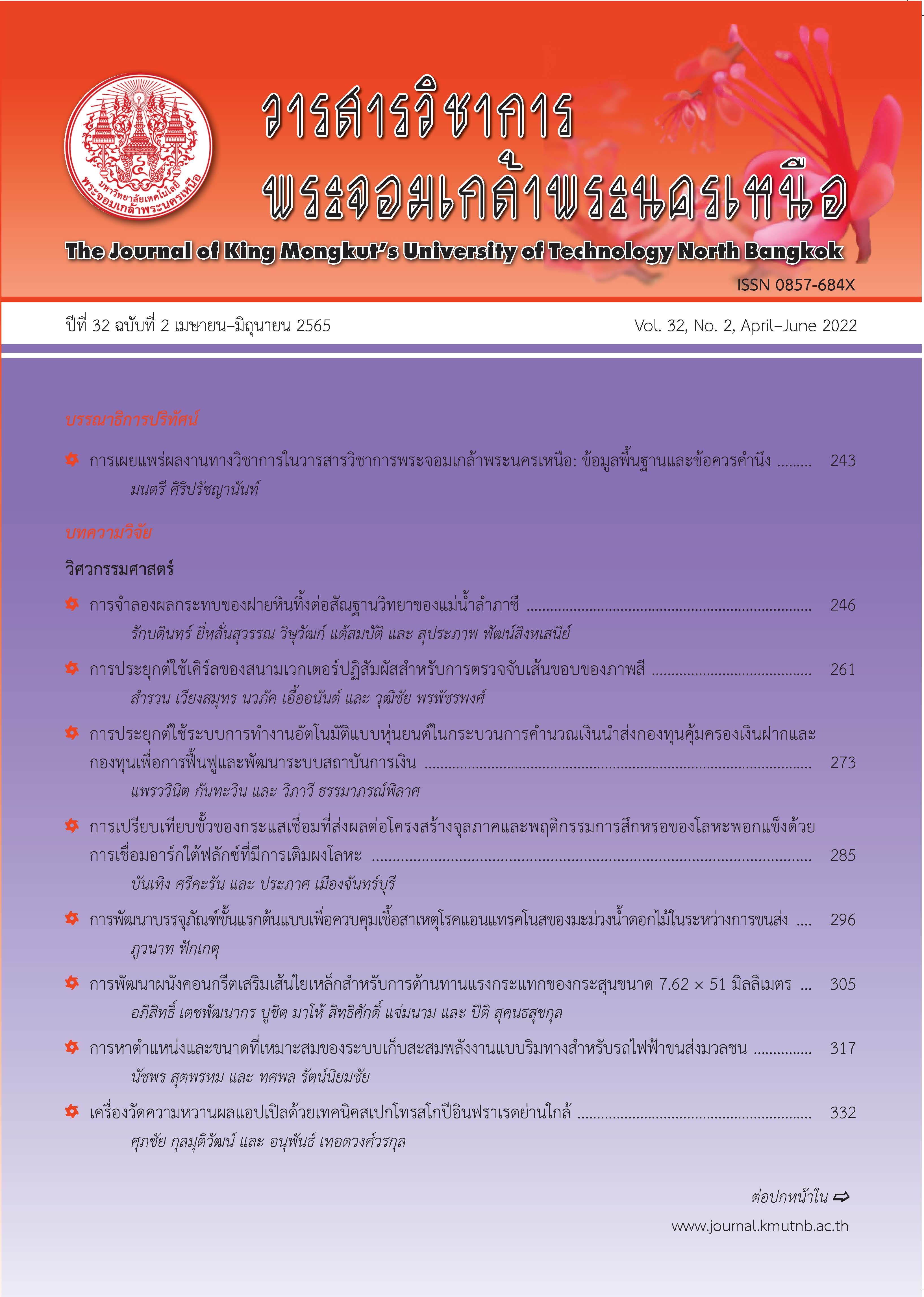เครื่องวัดความหวานผลแอปเปิลด้วยเทคนิคสเปกโทรสโกปีอินฟราเรดย่านใกล้
Main Article Content
บทคัดย่อ
งานวิจัยนี้พัฒนาเครื่องวัดความหวานของแอปเปิลแบบไม่ทำลายผลด้วยค่าการดูดกลืนแสงอินฟราเรดย่านใกล้ (near infrared, NIR) ที่วัดในแบบสะท้อนกลับ เครื่องเป็นแบบพกพามีชนาดกว้าง 23.6 ซม.ยาว 35 ซม. และสูง 25 ซม. ประกอบด้วย กล่องวางแอปเปิล แหล่งกำเนิดแสง สเปกโทรมิเตอร์ เส้นใยนำแสงสะท้อน และคอมพิวเตอร์ควบคุม ในการสร้างสมการประเมินความหวานสำหรับนำมาเขียนรหัสคำสั่งในโปรแกรมควบคุม ใช้แอปเปิลพันธุ์ฟูจิ 100 ผล มาวัดการดูดกลืนแสงอินฟราเรดย่านใกล้ในช่วงความยาวคลื่น 900 ถึง 1700 นาโนเมตร และค่าความหวาน (ปริมาณของแข็งที่ละลายได้) แล้วนำมาวิเคราะห์ด้วยเทคนิค partial least squares regression analysis สมรรถนะของสมการทำนายความหวานที่สร้างให้ค่า correlation coefficient (r) เท่ากับ 0.81 และค่าความคลาดเคลื่อนในการทำนาย (root mean square error of prediction, RMSEP) เท่ากับ 0.69 Brix สำหรับการทดสอบความแม่นยำในการวัดความหวานผลแอปเปิลของเครื่องวัดความหวาน นำค่าสัมประสิทธิ์การถดถอยที่ได้จากสมการประเมินความหวานมาเขียนรหัสคำสั่งในโปรแกรม แล้วทดสอบแอปเปิลพันธุ์ฟูจิที่ซื้อมาที่ช่วงเวลาแตกต่างจากแอปเปิลที่ใช้สร้างสมการ โดยนำมาวัดการดูดกลืนแสง NIR ด้วยเครื่องวัดความหวาน พบว่า เครื่องให้ความแม่นยำการประเมินค่าความหวานเปรียบเทียบกับค่าความหวานอ้างอิง ด้วยค่าความคลาดเคลื่อนในการทำนาย (RMSEP) เท่ากับ 0.75 Brix เครื่องวัดความหวานด้วยการวัดการดูดกลืนแสงอินฟราเรดย่านใกล้สามารถวัดความหวานของแอปเปิลได้ภายในเวลา 5 วินาที
Article Details

อนุญาตภายใต้เงื่อนไข Creative Commons Attribution-NonCommercial-NoDerivatives 4.0 International License.
บทความที่ลงตีพิมพ์เป็นข้อคิดเห็นของผู้เขียนเท่านั้น
ผู้เขียนจะต้องเป็นผู้รับผิดชอบต่อผลทางกฎหมายใดๆ ที่อาจเกิดขึ้นจากบทความนั้น
เอกสารอ้างอิง
Medthai. (2020, July 19). Apple 19 Items of Properties and Benefits of Apples. [Online]. Available: https://medthai.com/แอปเปิล.
V. Cortés, J. Blasco, N. Aleixos, S. Cubero, and P. Talens, “Monitoring strategies for quality control of agricultural products using visible and near-infrared spectroscopy: A review,” Trends in Food Science & Technology, vol. 85, pp. 138–148, 2019.
R. K. Cho, M. R. Sohn, and Y. K. Kwon, “New observation of nondestructive evaluation for sweetness in apple fruit using near infrared spectroscopy,” Journal of Near Infrared Spectroscopy, vol. 6(A), pp. A75-A78, 1998.
M. Ventura, A. Jager, H. Putter, and F. P. M. M. Roelofs, “Nondestructive determination of soluble solids in apple fruit by near infrared spectroscopy,” Postharvest Biology and Technology, vol. 14, no. 1. pp. 21–27, 1998.
R. Lu and D. Ariana, “A Near Infrared sensing technique for measuring internal quality of apple fruit,” Applied Engineering in Agriculture, vol. 18, no 5. pp. 585–590, 2002.
S. Saranwong, J. Sornsrivichai, and S. Kawano, “Predictions of ripen stage quality of apple fruit from its harvest quality measured nondestructively by near infrared spectroscopy,” Postharvest Biology and Technology, vol. 31, no. 2, pp. 137–145, 2004.
S. N. Jha and R. Garg, “Non-destructive prediction of quality of intact apple using near infrared spectroscopy,” Journal of Food Science and Technology, vol. 47, no. 2, pp. 207–213, 2010.
Z. Guo, M. Wang, A. A. Agyekum, J. Wu, Q. Chen, M. Zuo, H. R. El-Seedi, F. Tao, J. Shi, Q. Ouyang, and X. Zou, “Quantitative detection of apple watercore and soluble solids content by near infrared transmittance spectroscopy,” Journal of Food Engineering, vol. 279, pp. 109955, 2020.
C. A. T. Dos Santos, M. Lopo, R. N. Páscoa, and J. A. Lopes, “A review on the applications of portable near-infrared spectrometers in the agro-food industry,” Applied Spectroscopy, vol. 67, no. 11, pp. 1215–1233, 2013.
Y. B. Ying, X. Fu, and H. Lu, ”Experiments on predicting sugar content in apples by FT-NIR technique,” Journal of Food Engineering, vol. 80, no. 3, pp. 986–989, 2007.
S. Fan, Q. Wang, X. Tian, G. Yang, Y. Xia, J. Li, and W. Huang, “Non-destructive evaluation of soluble solids content of apples using a developed portable Vis/NIR device,” Biosystems Engineering, vol. 193, pp. 138–148, 2020.
Y. Ying and Y. Liu, “Nondestructive measurement of internal quality in pear using genetic algorithms and FT-NIR spectroscopy,” Journal of Food Engineering, vol. 84, no. 2, pp. 206–213, 2008.
L. K. Sørensen and S. Dalsgaard, “Determination of clay and other soil properties by near infrared spectroscopy,” Soil Science Society of America Journal, vol. 69, no. 1, pp. 159–167, 2005.
N. M. Faber and R. Rajko, “How to avoid over-fitting in multivariate calibration—The conventional validation approach and an alternative,” Analytica Chimica Acta, vol. 595, no. (1–2), pp. 98–106, 2007.
K. Włodarska, I. Khmelinskii, and E. Sikorska, “Evaluation of quality parameters of apple juices using near-infrared spectroscopy and chemometrics,” Journal of Spectroscopy, pp. 1–8, 2018.
K. Sakulnarmrat and P. Jannok, “Study of the spectroscopic data analysis pretreatments for enhancing performance of NIR calibration model for determining the brix value of Japanese pear,” Naresuan University Journal: Science and Technology (NUJST), vol. 25, pp. 32–40, 2017 (in Thai).
Jr. J. Workman and L. Weyer, Practical Guide and Spectral Atlas for Interpretive Near-infrared Spectroscopy. CRC press, 2012, pp. 63. [18] P. Williams, (2007). Near-infrared Technology— Getting the Best out of Light Edition 5.0. Inc., Nanaimo, Canada, 2007, pp. 69–102.

